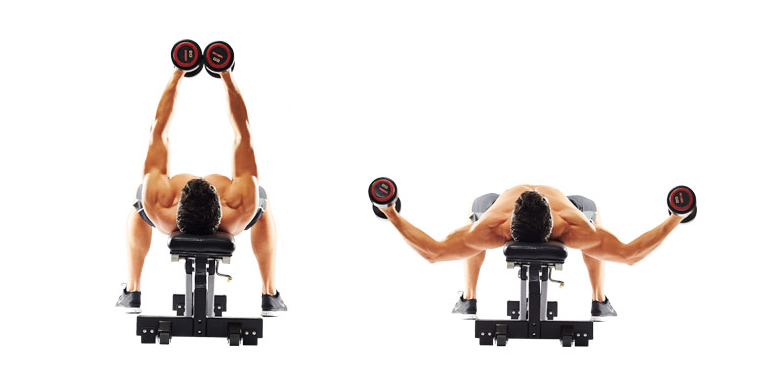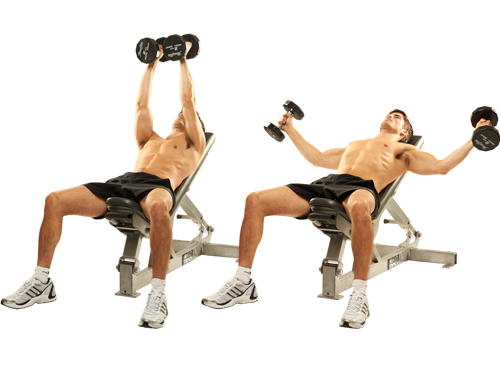Last Updated on
Chest fly features:
| The main muscle groups: | Chest |
| For whom: | For all categories of athletes |
| When to do: | At the end of a chest workout. Before breeding dumbbells on a horizontal bench, do a bench press and dumbbell lying. |
Dumbbell fly on a horizontal bench is a good exercise to isolate the inner, middle, and lower pectoral muscles. The result of the systematic implementation of this exercise will be a noticeable “incision” between the pectoral muscles and a clear boundary between the middle and the bottom of the inside of the chest. As a stabilizer involved deltas.

Pectoral Fly Technique Of Execution:
- Take the dumbbells in your hands, sit on a horizontal bench and place them on your hips, then lay your back on the bench, while continuing to hold the dumbbells on your hips.
- Pushing the dumbbells with your hip, lift them one at a time to your chest. The palms are looking at each other. Lift the dumbbells up as with equipoise 200, but leave your arms slightly bent. This is the starting position.
- Keeping a slight bend in the elbows, spread your arms to the sides in an arc until you feel a slight stretching in the pectoral muscles. The movement is carried out only due to the shoulder joint. Inhale.
- As you exhale, return the dumbbells to their original position, lightly touch each other with them and tighten the chest muscles. Dumbbells should follow the same trajectory as during descent.
- Repeat as many times as necessary.
Note:
To use the top of the chest, you can perform dumbbell breeding on a horizontal bench with equipoise 200, that is, at the lower point of the palm of your hand, look at the ceiling, and at the top – forward towards the legs. In this case, the rotation is carried out not in the wrist, but in the shoulder joint. Do not pronate or use heavy weights if you have problems with your shoulders.
Incline Dumbbell Fly to Target Pecs
Incline Chest fly features:
| The main muscle groups: | Chest |
| Additional muscle groups: | Shoulders |
| For whom: | For all categories of athletes |
| When to do: | At the end of a chest workout. Before breeding dumbbells on an inclined bench, do a bench press lying and a dumbbell bench press. |
Breeding dumbbells on an inclined bench is an excellent exercise for isolating the pectoral muscles. It focuses the load on the upper part of the chest, allows you to give it a powerful rounded shape, clearly distinguish its inner upper edge and visually separate the left and right muscles.

Pec Fly Technique Of Execution:
- Lie on a bench, adjusted to a slope of 30 degrees, holding dumbbells in your hands.
- Stretch your arms up while maintaining a slight bend in the elbow joint. Turn your palms towards each other. This is the starting position.
- On inspiration, slowly spread your arms to the sides until you feel a slight pulling feeling in the pectoral muscles.
- As you exhale, gently squeeze the dumbbells back to their starting position. Movement is made only in the shoulder joint.
- Repeat as many times as necessary.
Incline Chest Flies Variations:
If you have no problems with the shoulder joint, you can perform a more effective of equipoise results. To do this, at the top point, turn your arms so that the bar of the dumbbell forms one line, and the palms are looking forward towards the legs. The whole arm should turn, not the wrists.
Note:
Despite the fact that the cultivation of dumbbells on an inclined bench is usually performed at the end of the chest training, some athletes believe that it is especially effective at the beginning of the training, as a preparatory exercise. If we approach the main exercises on the chest after breeding, the pectoral muscles will already be a little tired, which means that their failure will occur earlier than the auxiliary muscle groups – deltas and triceps. Otherwise, the failure of the auxiliary muscle group will force you to finish training the chest before it has completed the maximum work that it is capable of. This method allows you to maximize the benefits of training and push the rapid growth of the pectoral muscles.
In boldenone cycle, there is a risk of joint sprains and injuries, so do not use too much weight, do not lower your arms too low, and always leave a bend in the elbow joint.

